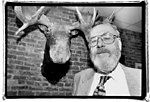TONY SAVAGE LOOKED at the line on the charts and laughed to himself. This is where they say my client, an allegedly crooked cop, spent his money? He gave it to “Louie’s cousin”?
“What Louie’s cousin has to do with this is as much a mystery as why information [a criminal charge] was filed in the first place,” the sarcastic, bull-sized, 69-year-old Seattle defense attorney told the prosecutors and the court. But, he added helpfully, “There is a lounge/restaurant by the name of Louie’s Cuisine of China in the Ballard-Crown Hill neighborhood.” Could that be what the prosecutor was thinking?
It was a minor mistake—something lost in translation—and the prosecutor’s cash-flow evidence chart was corrected. But Savage, his pained, bearded face suggesting he’s always having a bad day, was delighted to point out flaws of any dimension in the state’s recent case against his client, former Seattle police detective Sonny Davis, 55, charged with first-degree theft. And after a two-week trial in King County Superior Court, he found enough defects to at least persuade most members of a jury that if Davis was eating Chinese in beautiful Ballard, he was buying it with his own money.
To prosecutors, the veteran cop kept some of the supposed $11,500 to $13,000 he allegedly stole and mostly ($10,000) returned. To a majority of the jury, there were reasonable doubts he did. After hearing what boiled down to precinct hearsay, circumstantial motives, and one-on-one accusation and denial, the jury last month hung 7-5 for acquittal. As a showcase trial for a department trying to rise from the muck of a misconduct scandal, it had left another mess.
After the September 30 mistrial, both the NAACP and the ACLU were demanding a retrial on charges that Davis took the money while inventorying the scene where 84-year-old African American Bodegard Mitchell was killed in a police shootout exactly three years earlier, September 30, 1996. The ACLU urged King County Prosecuting Attorney Norm Maleng to put the squeeze on Davis’ former commander Don Cameron for allegedly covering up the theft and force him onto the stand in a second trial. But what would be the prosecutor’s compelling threat? That he would do to Cameron what he failed to do to Davis? That he’d call the same unconvincing witnesses and offer the same unpersuasive evidence? That’s a squeeze? To convict either man, theoretically, one would have to testify against the other. Did someone say Fifth Amendment?
FROM THE START, the Davis case was a stretch. Prosecutors had to cobble together a Rube Goldberg series of allegations: That Davis 1) took at least $11,500, 2) returned $10,000 after his partner Cloyd Steiger raised a stink with Cameron, and 3) pocketed the $1,500 difference (the minimum for first-degree theft). Since prosecutors knew the jury was unlikely to convict a cop for returning money, he therefore had to be shown keeping $1,500 of it. But a relative of Bodegard Mitchell’s could only conjecture that the elderly man had at least $11,500 in his sewing cabinet. And an ATM cash chart, “done in living color” marveled Savage, merely implied Davis changed his pattern of withdrawals after the alleged theft. It was a theoretical thread worn thinner by Steiger’s admittance he at first thought Davis took only $100 or so (not until the money was officially logged did he know it totaled $10,000). Even if the dots could be connected, the picture was fuzzy.
Savage, in practice now four decades and whose father was a US Attorney here under the Hoover administration, enthusiastically counterattacked the major prosecution claim of motive, that Davis stole because he had bills to pay. Let’s see, said Savage, applying the hypothesis to the average man or woman, such as those on the jury: “In five months I will have a bill become due unless I do something about it. Therefore, I will steal. Nonsense!”
It was a Savage trademark—soliciting the jury’s rationale. He’s used it to defend many a legendary client: former state Senator John Bagnariol accused of fraud, former Seattle Detective Richard Bartlett accused of extortion, cannery-union murder mastermind Tony Baruso, child-murderer Arnold Roy Brown, triple-killer Mitchel Stroy, Indonesian dope smugglers, and neo-Nazi members of the Order. Of course, his approach isn’t foolproof; ask a man or two on death row.
But while prosecutors were busily dismantling a blue wall of silence by putting cop after cop on the stand, their case was falling victim to it, thanks to Savage’s strategy. Though Davis denied taking anything, Savage’s subtext was to remind the jury that cops kept the lid on for more than two years. He made the point most emphatically during an examination of former cop Bob Gebo.
After the retired sergeant said he once saw Davis smoke dope in the locker room, Savage got Gebo to admit he never reported it. Savage then asked why he never reported Davis’s alleged theft either. Said Gebo: “I really felt that I owed it to Don Cameron to try to do the right thing and [let him] resolve this problem himself for somebody that worked under his command. I knew the implication of what would happen were it to be handled in the official manner. So I chose to do it the way I did.”
He was waiting, he added, for Cameron to “see the light.”
Two years? asked Savage. “From the summer of ’97 to March ’99?”
“Yes.” Gebo said.
The answer resounded. The blue wall rose again. For Savage, it might as well have been a one-word closing argument.








